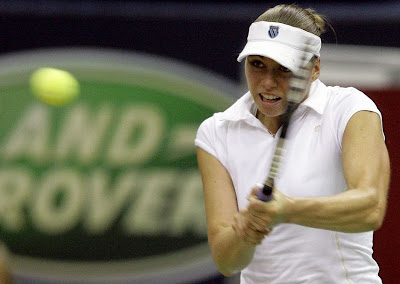What is the Backhand?
For right handed tennis players, a backhand involves the player swinging from the left side of your body, across your chest and over your right shoulder. This may be done with either one hand and thus is known as the one-handed backhand or with both hands and is known as the double handed backhand.
The choice of which to use is usually a choice of the player. Most players of the game who go for a little more power on their backhand prefer the single backhand as opposed to people who seek a higher consistency and higher chance of landing the ball in the court and go for the double handed backhand.
For right handed tennis players, a backhand involves the player swinging from the left side of your body, across your chest and over your right shoulder. This may be done with either one hand and thus is known as the one-handed backhand or with both hands and is known as the double handed backhand.
The choice of which to use is usually a choice of the player. Most players of the game who go for a little more power on their backhand prefer the single backhand as opposed to people who seek a higher consistency and higher chance of landing the ball in the court and go for the double handed backhand.
 |
| Vera Zvonerenka playing the double handed backhand |
How do I play the Backhand?
To play a good backhand, one needs to first be ready for the ball. So it is advisable that the player is in the ready position for the backhand. The ready position is where the player faces the net with one hand firmly holding the lower end of the racket as the other holds the just a little above the other hand. This creates an angle of about 45 degrees. Most coaches call this the “Crab” hand. At this point, you are ready to play the ball. The racket face should be open during this phase.
Want to start playing tennis? Find a good sparring partner
Footwork for backhand
Now, as the ball arrives, you move your right foot in such in a way that your right side faces the net. To maximize your ball control, keep your eye on the ball all this while as you slightly bend your knees and prepare for contact with the ball.
Contact with the ball
The racket face to during this stage should be slightly closed. When the ball finally arrives, swing across your shoulder– (this is where the decision of whether you swing with the single-handed or double-handed backhand comes in). The swing across the shoulder for the single-handed backhand may not be a complete swing as the human arm can swing to only certain limits. This is one of the advantages of the double handed backhand which has more of a complete swing.
To play a good backhand, one needs to first be ready for the ball. So it is advisable that the player is in the ready position for the backhand. The ready position is where the player faces the net with one hand firmly holding the lower end of the racket as the other holds the just a little above the other hand. This creates an angle of about 45 degrees. Most coaches call this the “Crab” hand. At this point, you are ready to play the ball. The racket face should be open during this phase.
Want to start playing tennis? Find a good sparring partner
Footwork for backhand
Now, as the ball arrives, you move your right foot in such in a way that your right side faces the net. To maximize your ball control, keep your eye on the ball all this while as you slightly bend your knees and prepare for contact with the ball.
Contact with the ball
The racket face to during this stage should be slightly closed. When the ball finally arrives, swing across your shoulder– (this is where the decision of whether you swing with the single-handed or double-handed backhand comes in). The swing across the shoulder for the single-handed backhand may not be a complete swing as the human arm can swing to only certain limits. This is one of the advantages of the double handed backhand which has more of a complete swing.
After contact
Move your right foot back again and get back into the ready position. Remember to keep your eye on the ball through every stage. This ensures you hit with higher accuracy with a good chance of directing the ball where you want it to go. Try to do some drills with your coach or sparring partner to increase your consistency and power of the shot over time.Also for you reading; The Giant move
No comments:
Post a Comment